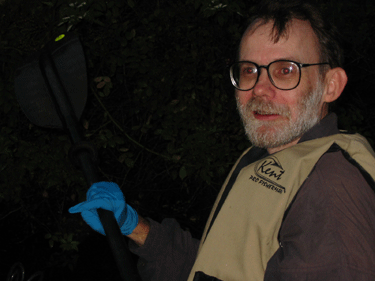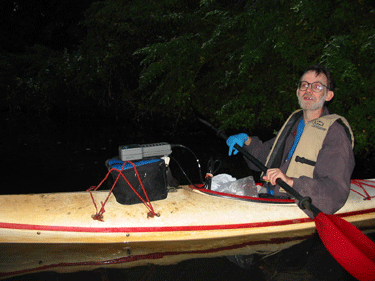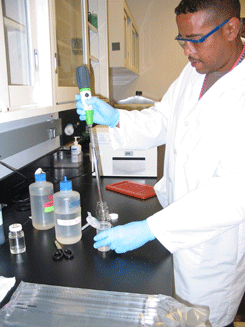The Mad Kayaker
Air Date: Week of November 4, 2005
Roger Frymire has been patrolling the Charles River watershed in Massachusetts for over a decade, testing viral and bacterial levels that have been appearing at alarming highs. Living on Earth's Dennis Foley has this portrait of an average citizen who's putting the problem of water pollution on the radar.
Transcript
GELLERMAN: New England has—so far—been spared the more devastating effects of this year’s hurricane season, but residual storms traveling up the east coast have caused a lot of flooding and overflowing of sewers.
In the Boston area, aging drainpipes, designed to flush storm water into Charles River Watershed, have been dumping thousands of gallons of untreated sewage into the river. And it's not just when there are storms.
But one man has refused to go with the flow, and for more than a decade, he has been urging communities to clean up their act. Living on Earth’s Dennis Foley has this portrait of the “Mad Kayaker.”
[RAIN AND WIND; SOUND OF UNLOADING KAYAK; WALKING DOWN TO RIVER]
FOLEY: It’s 4:30 in the morning on this chilly, rain soaked New England day. While most people are still a good hour away from hitting the snooze button on their alarm clocks, Roger Frymire is wide awake and lugging his plastic kayak down to a local river’s edge.
[WALKING IN RAIN WITH CLUNKING KAYAK]
FOLEY: Oddly enough, this is exactly how he likes his weather conditions, thank you very much.
FRYMIRE: We got .27 of an inch last night, which is going to give us some very good overview since it was a short storm….

(Photo: Dennis Foley)
FOLEY: Roger Frymire is an unassuming, 49-year-old retired computer scientist. This elfish and spectacled fellow has taken on a new mission in life: clean water advocacy. Though some folks might consider what he’s been doing with his time a bit eccentric, to several watershed organizations he’s a one-person clean water army.
[FRYMIRE LOADS EQUIPMENT INTO KAYAK]
FOLEY: On this particular morning, we’re by the edge of the Mystic River in Medford, Massachusetts. Frymire loads his boat to prepare for a trip upstream to Alewife Brook. There, he’ll test water around three storm water drainage pipes, also known as Combined Sewer Overflows. These 19th Century era pipes were designed to steer excessive storm water directly into the rivers in order to prevent flooding. Nearly a dozen of these pipes still exist along Massachusetts’ rivers despite efforts to replace them with newer filtration systems.
FRYMIRE: Any time you get a rain, everything is washed off the land. You’ve got animal feces, you’ve got water washed off the streets into storm drains, and a big problem on Alewife Brook is actually sewage – though this wasn’t a large enough rain to set off the Combined Sewer Overflows which make the whole river stink when it rains intensely.
FRYMIRE [LISTS EQUIPMENT AS HE LOADS]: …bag of assorted sample vials and equipment. On top of it, I’ll set my meter…
FOLEY: The importance of his floating science lab, strapped to the top of his kayak with bungee cords, cannot be overstated. After all, his water samples will be submitted to the New England EPA and tested at the agency’s lab. But, to be clear, Roger Frymire is employed by no such organization. In fact, he works alone, and at least some of his motivations are personal.
FRYMIRE: After retiring in the late `80s I started kayaking, and after a few years of that I noticed that any time I dunked into the river, the Charles River, no matter which direction I paddled, in a little bit I’d smell sewage. And I got sick of it.
FOLEY: Frymire has collected an estimated 1,500 water samples along the 80 miles of the Massachusetts’ Charles River and the 17-mile-long Mystic. Many local water commissions regard him as THE authority on the waterways here. His services come free of charge. He just hopes that the towns sharing acreage along the water’s edge will at least try to meet standards of the 1972 Clean Water Act.
[KAYAK LAUNCHES INTO THE RIVER]
FOLEY: Frymire launches his trusty dented and duct-taped vanilla-white kayak into the quiet waters of the Mystic. The work he’s been doing has earned him a playful moniker from one EPA biologist: “The Mad Kayaker”.

(Photo: Dennis Foley)
[PADDLING UP RIVER AND CHATTING]
FOLEY: Today he hopes to find – or rather, hopes not to find – high bacterial counts that include fecal coliform. Fecal bacteria is commonly found around many of the river drainage pipes after heavy rainstorms such as the one the night before.
FRYMIRE: Oh, the waters are starting to appear just a little bit gray, unfortunately, which to me means that there’s been some sewage in the water overnight.
FOLEY: At times, he’ll employ less scientific methods in his quest. His nose has become quite adept at detecting any peculiar odors unbecoming of the river’s normal smells, and he’s also got a keen eye out for...
FRYMIRE: Objectionable floatables.
FOLEY: Objectionable floatables?
FRYMIRE: Anything from hypodermics, condoms, sanitary pads, rafts of toilet paper or even the bobbing brown lumps occasionally. None of it’s very appetizing.
FOLEY: Indeed.
[PADDLING UP RIVER]
FOLEY: Up river, our boats glide through waters lush with flowering lily pads, swaying green reeds and a habitat active with wild ducks and geese.
[SOUNDS OF DUCKS AND GEESE]
FOLEY: Quite by accident, we startle a great blue heron breakfasting along the river shoreline.
FRYMIRE: Pretty.
FOLEY: Beautiful.
FRYMIRE: He flushed back behind us so we’ll only bother him once today.
FOLEY: But strewn beneath the waters is a veritable junkyard, abundant with sunken shopping carts, rusted bicycles and enough baseballs, tennis balls and basketballs to outfit an entire high school athletic department. Frymire takes this in stride.
FRYMIRE: After awhile, you have to let the small problems slide.
[SOUND OF FRYMIRE TAKING WATER SAMPLES]
FOLEY: We’ve arrived at one of the aging pipes, a toothy looking maw frowning under the weight of decay. Frymire dons blue rubber gloves as he takes several test tube samples directly from the murky gray-brown water’s surface.
FRYMIRE: Still waiting for the dissolved oxygen to stabilize.
FOLEY: He’ll report his findings directly to places such as the EPA, and to his old training grounds, the non-profit Charles River Watershed Association. The CRWA was founded in 1965 in response to public concern about the decline of the Charles River’s water quality. The group provides EPA-approved training for people like Roger Frymire interested in helping their cause.
Kate Bowditch, the group’s senior environmental scientist, echoes what many in water quality advocacy groups believe: that citizen water watchdogs are essential.
BOWDITCH: You need to have citizens out there who really care about what’s going on and who are willing to say something about it, who are willing to put in some of their own time. You need the Roger Frymires of the world. There’s not a town or a city or an industry that can resist that kind of organization and that kind of data and that kind of information.
[EPA LAB DOOR ENTRANCE]
MAN: OK, Roger, what do we have today?
FRYMIRE: We have one sample, No. 99...

Biologist Nathan Rains processes water samples at the Mass-EPA laboratory. (Photo: Dennis Foley)
[WATER VIALS SHAKING]
FOLEY: It will take these samples a full 24 hours to incubate. Past samples have revealed “critter” levels, as Frymire puts it, 10,000 times this states legal swimming levels. Some may ask why it should take a volunteer like Roger Frymire to deliver evidence of contaminated water. That’s the EPA’s job, isn’t it? But EPA lab biologist, Tom Faber, points out:
FABER: There’s limited resources. I mean, we can’t do everything. We can’t sample every river and every pipe. There’s thousands and thousands of pipe.
FOLEY: Faber acknowledges Frymire helps fill in the gaps.
FABER: Because Roger’s out on the river he knows the river very well. He kayaks it daily in some cases, so he’s able to bring samples in, we’re able to analyze them. We work together on some of the problem areas.
FOLEY: Over the years, Frymire has been credited for making towns fix a significant share of damaged drainpipes, help control water contamination levels, and change water pollution permit rules. He’s not one to rest easy on his laurels, though.
[SOUND OF PADDLING]
FOLEY: Frymire is determined to continue improving the quality of Boston’s waterways, even if his actions are a bit unorthodox.
FRYMIRE: After all, somebody’s gotta be a little off their noggin’ to go out in all this sewage and stink voluntarily.
FOLEY: For this “Mad Kayaker,” a little “off your noggin’” seems to have gone a long way.
FRYMIRE: (LAUGHS)
FOLEY: For Living on Earth, I’m Dennis Foley in Boston.
[SOUND OF PADDLING]
Links
Charles River Watershed Association
Living on Earth wants to hear from you!
Living on Earth
62 Calef Highway, Suite 212
Lee, NH 03861
Telephone: 617-287-4121
E-mail: comments@loe.org
Newsletter [Click here]
Donate to Living on Earth!
Living on Earth is an independent media program and relies entirely on contributions from listeners and institutions supporting public service. Please donate now to preserve an independent environmental voice.
NewsletterLiving on Earth offers a weekly delivery of the show's rundown to your mailbox. Sign up for our newsletter today!
 Sailors For The Sea: Be the change you want to sea.
Sailors For The Sea: Be the change you want to sea.
 The Grantham Foundation for the Protection of the Environment: Committed to protecting and improving the health of the global environment.
The Grantham Foundation for the Protection of the Environment: Committed to protecting and improving the health of the global environment.
 Contribute to Living on Earth and receive, as our gift to you, an archival print of one of Mark Seth Lender's extraordinary wildlife photographs. Follow the link to see Mark's current collection of photographs.
Contribute to Living on Earth and receive, as our gift to you, an archival print of one of Mark Seth Lender's extraordinary wildlife photographs. Follow the link to see Mark's current collection of photographs.
 Buy a signed copy of Mark Seth Lender's book Smeagull the Seagull & support Living on Earth
Buy a signed copy of Mark Seth Lender's book Smeagull the Seagull & support Living on Earth

